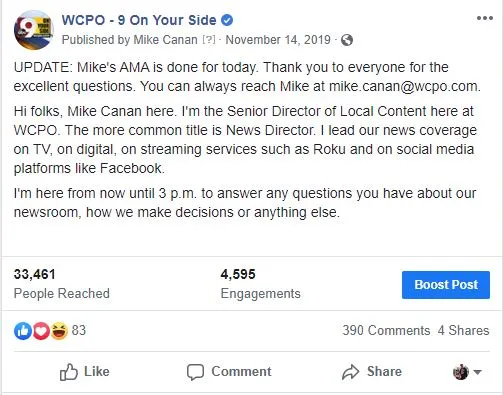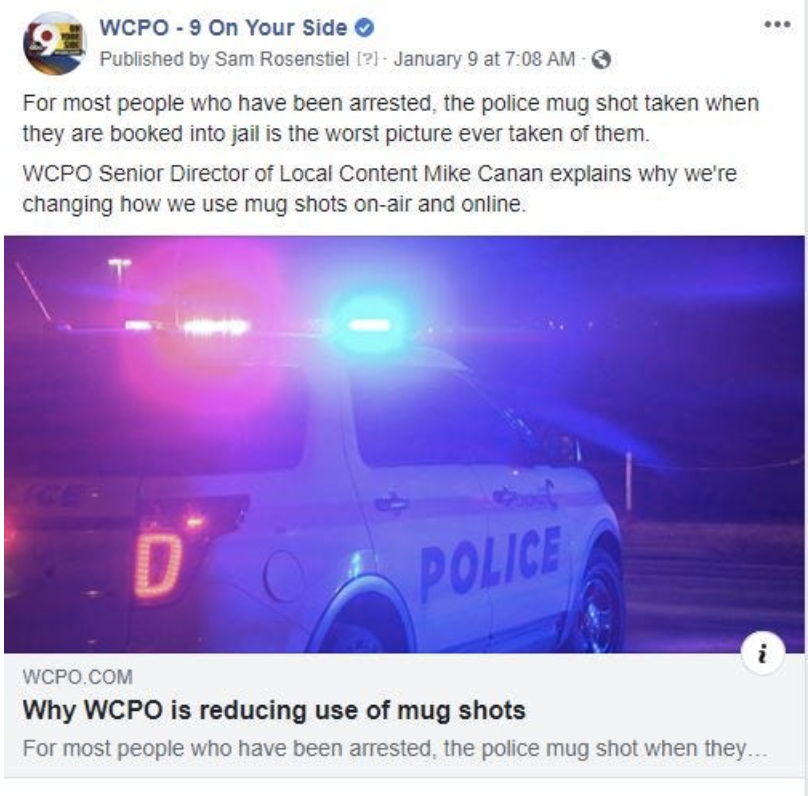
Here’s how Mike Canan at WCPO hosts AMAs (also called ask me anythings) with their station’s TV viewers on Facebook.
I do Q&As with viewers on Facebook, and here’s why it’s worth it
Ask Me Anything.
That last word is a little daunting — especially if you are a newsroom leader.
But for too long transparency hasn’t been a priority in our industry. Our audiences don’t understand who we are, what we do or why we do it. Without information, it’s easy to see why people don’t trust the media and make assumptions about us and our motives.
That’s why as editor in chief of WCPO.com back in 2015, I took to Reddit for an Ask Me Anything, or AMA.
That first Reddit AMA went well. There were, of course, some harsh critics and some off-the-wall questions. But mostly the questions, comments and feedback were thoughtful, genuine and interesting.

Since then, I have done a second AMA on Reddit and now two on Facebook.
The most recent Facebook AMA took place in November — about two years after my last Facebook AMA.
What I learned
The biggest difference I noticed is that participation was WAY higher than it was in November 2017. There were 390 total comments.

After the AMA, I sent these observations of trends to our newsroom team:
- People want positive news. They value it and believe if the news is too negative it doesn’t accurately portray our community.
- They want follow up.
- Quality control matters. Proofreading online, on air and on Facebook is important.
- Our morning weather push alerts are a huge hit!
This direct feedback has shaped newsroom discussions and how we go about doing our jobs. We have put more emphasis on quality control, for example.
Since that AMA, I have received emails from Facebook followers who I don’t think would have contacted me before.
When I talk about these efforts with other newsroom leaders, I often hear things like: “Yeah, well you are good at that sort of thing.”
But here’s the thing: I don’t think I’m special. I don’t think communicating with your audience in this way requires any kind of skill that journalists don’t already have.
It requires empathy, honesty and the ability to have a thick skin and avoid defensiveness.
Five tips for conducting your own AMA
Here are some of the things that I do during an AMA to have (mostly) positive experiences:
1. Ask for specifics
A common complaint I’m sure most newsrooms hear is that they are biased or one-sided. Many journalists immediately respond that they are not biased. But if we are truly honest with ourselves, we all have biases. I know I do. I hope that my years of experience and professional training allow me to understand my biases and keep them from influencing my journalism. But the reality is I’m sure my biases impact my journalism.
It’s not realistic to think that in a newsroom full of humans a little bias has never creeped in somewhere. Or did your team pick up a wire story that is biased?
Sometimes the complaints of bias are accurate.
Instead of getting defensive, I try to ask for a specific example.

Maybe the person can’t produce a specific example. Maybe you can explain to the person why the example isn’t biased or one-sided, but at least you are talking in specifics. Or maybe there is an example where your team made a mistake. You can learn from this experience and get better.
2. Acknowledge we aren’t perfect
Sometimes we make mistakes. Just like when you run a correction, I’ve found the best course of action is to own up to your shortcomings and promise to try to do better.

3. Acknowledge that media in general isn’t perfect
I don’t want to be held responsible for a lot of the work I see other journalists do. I find it constructive to acknowledge that the media landscape includes careless or irresponsible coverage. I then go on to explain how we work hard to be worthy of trust.
4. Answer them all
I try to set a certain amount of time I will be participating in the AMA and communicate that with the audience. Then during that time, I try to respond to every question or comment. Otherwise, I think it looks like you are dodging the tough questions or playing to a certain audience.
5. Show some personality
I also try to show that I’m human, too. Sometimes humor goes a long way. For example, when Eric Alley delivered a line from Monty Python and the Holy Grail, I responded with the next line of the movie.

Is it worth it?
You might think an AMA will take an enormous amount of time. I usually set aside about two to three hours. During that time, I am devoted almost entirely to the AMA. But that’s really it.
Yes, we are all busy. But if transparency and trust are truly a priority for your newsroom you can find a few hours for an AMA.
Of course, there are some people who will always hate you. Trust is hard to win and easy to lose. And like in real relationships, there are some people who might never trust you again.
But I’ve found that the effort, the transparency and the vulnerability win a lot of people over.

In the end, that’s why an AMA is worth it.
A few hours of time can help your audience better understand your newsroom — and maybe even win a few people over.
That’s worth facing down Facebook’s tough questions and critics.
Mike Canan is the Senior Director of Local Media Content at WCPO and an original partner with Trusting News. Contact him at mike.canan@wcpo.com. Follow him on Twitter or Instagram at @Mike_Canan.
At Trusting News, we learn how people decide what news to trust and turn that knowledge into actionable strategies for journalists. We train and empower journalists to take responsibility for demonstrating credibility and actively earning trust through transparency and engagement. Subscribe to our Trust Tips newsletter. Follow us on Twitter and LinkedIn. Read more about our work at TrustingNews.org.

Mike Canan
Mike Canan is the Director of Journalism Strategies at the Scripps Howard Foundation and an original partner with Trusting News.
